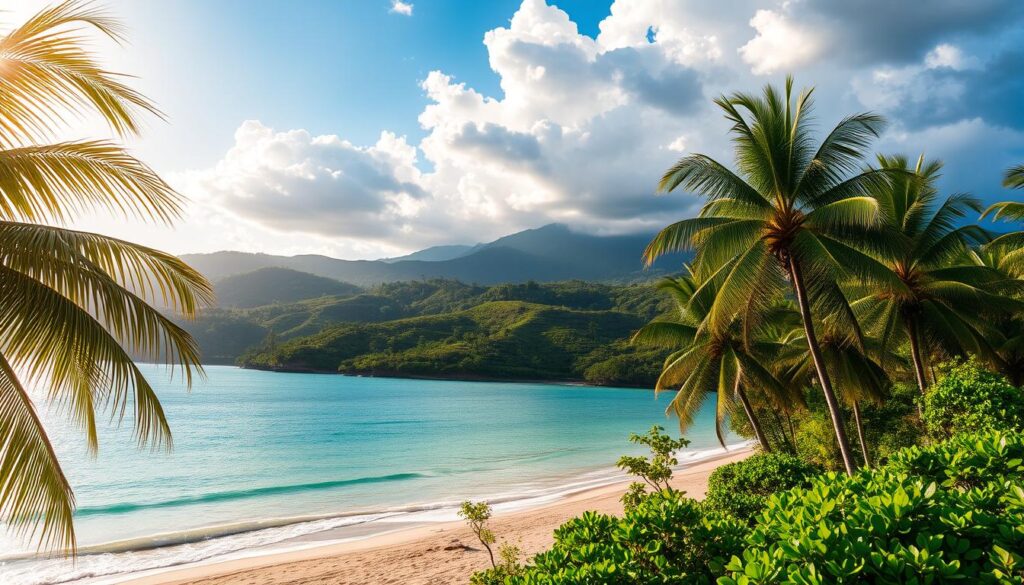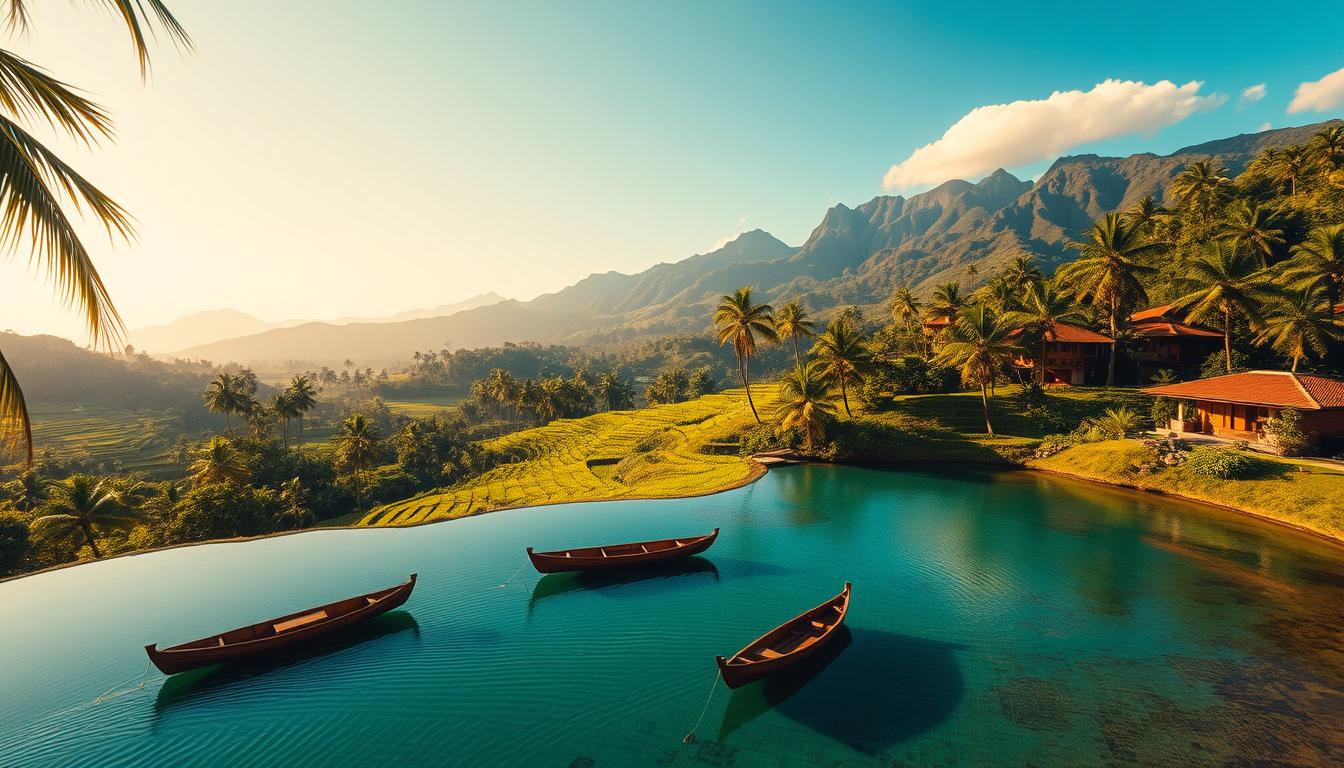Bali Travel Guide for First-Timers
With over 6 million international travelers yearly, Indonesia’s most famous gem isn’t just a tropical getaway—it’s a cultural phenomenon. Known as the Island of Gods, this destination blends ancient rituals with Instagram-worthy sunsets, creating a magnetism that’s hard to resist. Yet many newcomers underestimate one crucial fact: its 2,230 square miles hold over 20,000 temples and microclimates ranging from misty volcanoes to coral reefs.
Planning your inaugural visit can feel like solving a vibrant puzzle. Should you chase waterfalls in Ubud or surf breaks in Canggu? How do monsoon seasons affect your itinerary? Our resource cuts through the overwhelm, offering clear strategies to experience both iconic landmarks and hidden gems. You’ll learn why December’s “rainy season” might actually perfect your yoga retreat and how to respectfully engage with sacred sites.
Key Takeaways
- Over 20,000 temples and diverse landscapes require strategic itinerary planning
- Dry season (April-October) ideal for beaches; rainy months offer cultural immersion
- Visa-free entry for 30+ nationalities simplifies arrival logistics
- Mix popular areas like Seminyak with lesser-known regions for balanced exploration
- Local ceremonies occur daily – carry a sarong and learn basic etiquette
Introduction to Bali: Paradise, Culture, and Adventure

Imagine a place where emerald rice terraces meet vibrant ceremonies under coconut palms. This island’s magic lies in its ability to weave spiritual traditions into everyday life while offering modern thrills. Locals greet visitors with flower offerings and genuine smiles, creating an atmosphere unmatched in Southeast Asia.
Food lovers rejoice here. Street vendors serve Nasi Goreng bursting with lemongrass and chili, while beach clubs plate up fusion dishes. Don’t miss smoky satay skewers at twilight markets – they’re a rite of passage for hungry explorers.
| Experience | Cultural Highlight | Adventure Option |
|---|---|---|
| Ubud | Sacred Monkey Forest | Cycling through rice fields |
| Canggu | Traditional surf blessings | Catching ocean waves |
| East Coast | Water palace ceremonies | Snorkeling vibrant reefs |
Mornings might find you learning offerings-making from a grandmother, afternoons conquering rapids in jungle rivers. Evenings bring fire dances where legends leap from flickering shadows. This destination’s true power? Turning every sunset into a memory that sticks like tropical humidity.
With over 10,000 festivals yearly, there’s always something sacred or celebratory happening. Pack light clothes and an open mind – you’ll need both to fully embrace this island’s rhythm.
Understanding Indonesia Visa and Entry Requirements

Navigating entry protocols is simpler than you might think. Most visitors from the US and 90+ other nations qualify for streamlined access. Let’s break down what you need for smooth arrivals.
Visa on Arrival vs. 211A Visit Visa
The B1 Visit Visa, also known as Visa on Arrival (VoA), covers 30-day stays for tourism. You can apply online or at major airports. Need more time? Extend it once for another 30 days.
Planning a longer stay or business activities? The 211A Visit Visa requires advance application. This option suits digital nomads or those attending conferences. Processing takes 5-7 business days, so plan ahead.
Bali Tourist Tax Explained
Since February 2024, every international arrival pays IDR 150,000 (about $10). This fee supports cultural preservation and infrastructure. Pay it electronically during flight check-in or at dedicated counters.
Health protocols matter too. Complete the MPOX health pass form before flying – it’s mandatory since August 2024. Finally, submit your customs declaration within 72 hours of landing. These steps ensure you’ll be sipping coconut water by the pool faster.
When is the Best Time to Visit Bali? Seasons & Weather Insights

Timing shapes every great adventure. While this destination welcomes visitors year-round, understanding its climate patterns helps craft your ideal journey. Let’s explore how seasons influence activities, crowds, and even photo opportunities.
Sun-Drenched Days: April Through October
The dry season delivers postcard-perfect conditions. From April to October, expect endless blue skies ideal for snorkeling trips and temple hopping. Temperatures hover between 80-90°F (27-32°C) – warm enough for beach lounging without oppressive humidity.
Three months stand out:
- May: Rice terraces glow emerald post-harvest
- June: Ocean swells attract surfers worldwide
- September: Festival season begins with thinner crowds
Green Season Surprises: November to March
Don’t overlook the wet season. Morning showers give way to sunny afternoons, creating rainbows over jungles. You’ll find:
- 50% lower hotel rates at luxury resorts
- Vibrant ceremonies celebrating harvest cycles
- Prime conditions for photography enthusiasts
Rain typically arrives in brief bursts around 3 PM – perfect timing for spa treatments or cooking classes. Just pack quick-dry clothing and waterproof phone cases.
Pro tip: April and October often deliver dry season weather with shoulder-season pricing. Watch flight deals during these transitional months for maximum value.
Planning Your Itinerary: Essential Destinations in Bali
A well-planned route transforms a good trip into an unforgettable experience. Focus on balancing lively hotspots with serene escapes to capture the island’s essence. These three areas showcase distinct personalities while keeping logistics manageable.
Cultural Heart Meets Jungle Serenity
Ubud tops every itinerary for good reason. Wander through sacred monkey forests, practice yoga overlooking misty rice fields, or join traditional batik workshops. Its central location makes day trips to waterfalls and temples effortless.
Coastal Glamour & Nightlife
Seminyak dazzles with sunset cocktails at rooftop bars and designer boutiques. Foodies love its fusion restaurants serving jackfruit tacos and tuna tataki. By day, learn surf basics at beginner-friendly beaches.
Cliffside Luxury & Ocean Thrills
Uluwatu’s limestone bluffs host luxury hotels with infinity pools blending into the horizon. Experienced surfers chase barrel waves at Padang Padang, while couples book private dinners above crashing waves.
Spend 3-4 days in each area to avoid rush. Pair Ubud’s spiritual energy with Seminyak’s buzz, then unwind in Uluwatu’s coastal calm. Remember: distances look small on maps but traffic adds travel time – pack patience with your sunscreen!
FAQ
What’s the difference between a Visa on Arrival and a 211A Visit Visa?
How does the new tourist tax work?
Why is April to October considered the best time to explore?
Is it worth visiting during the wet season?
Which areas should first-timers prioritize?

Adam Peter is a finance, travel, and automotive writer with over a decade of experience. He creates clear, practical content to help readers manage their money, explore the world with confidence, and make informed decisions about cars and travel gear. His work blends expert insight with real-world usefulness.




